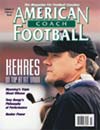AMERICAN FOOTBALL MONTHLY THE #1 RESOURCE FOR FOOTBALL COACHES
Article CategoriesAFM Magazine
|
Husker Powerby: Boyd EpleyDirector of Performance, Nebraska © More from this issue Looking back, it's hard to believe it. But just 30 years ago, coaches at the University of Nebraska were actually discouraging athletes from lifting weights for fear it would make them muscle bound and slower. My, have times changed in Lincoln. I first came to Nebraska in 1968, competing as a pole valuter on the track and field team. A back injury halted my valuting career in the spring of my junior year. To rehab my back, I went to the weight room every day where a few injured Husker football players began to join me in my routine. Due to my bad back, I was redshirted the following season. I spent that year training hard, running and lifting, and helping out anyone who was around. One of the athletes I helped was Joe Orduna, a star I-back who had knee surgery. Back then when you had knee surgery, your career was over. But Joe ....The full article can only be seen by subscribers.
|
|
|||||||
| HOME |
MAGAZINE |
SUBSCRIBE | ONLINE COLUMNISTS | COACHING VIDEOS |
Copyright 2025, AmericanFootballMonthly.com
All Rights Reserved





